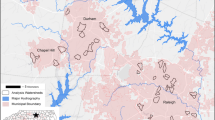Abstract
Landscapes were mapped as clusters of 2 or 3 land cover** types, based on their pattern within the clusters and tendency for a single type to dominate. These landscapes, called Landscape Pattern Types (LPTs), were combined with other earth surface feature data in a Geographic Information System (GIS) to test their utility as analysis units. Road segment density increased significantly as residential and urbanized land cover components increased from absent, to present as patch, to present as matrix (i.e., the dominant land cover type). Stream segment density was significantly lower in LPTs with an urbanized or residential matrix than in LPTs with either a forest or agriculture matrix, suggesting an inverse relationship between stream network density and the prevalence of human development other than agriculture in the landscape. The ratio of average forest patch size to total forest in the LPT unit decreased as agriculture replaced forest, then increased as residential and urban components dominated. Wetland fractal dimension increased as agriculture and residential land cover components of LPTs increased. Comparison of LPT and LUDA land cover area statistics in ecoregions suggested that land cover data alone does not provide information as to its spatial arrangement.
Similar content being viewed by others
References
Anderson, J.R., Hardy, E.E., Roach, J.T. and Witmer, R.E. 1976. A land use and land cover classification system for use with remote sensor data. U.S. Geological Survey, Professional Paper 964, Washington, DC.
Argialas, D.P. and Harlow, C.A. 1990. Computational image interpretation models: an overview and perspective. Photogrammetric Engineering and Remote Sensing, 56(6): 871–886.
Browder, J.A., May, L.N., Rosenthal, A. and Gosselink, J.G. 1989. Modeling future trends in wetland loss and brown shrimp production in Louisiana using thematic mapper imagery. Remote Sensing of Environment 28: 45–59.
Efron, B. 1979. Bootstrap methods: another look at the jackknife. The Annals of Statistics 7(1): 1–26.
Forman, R.T.T. and Godron, M. 1986. Landscape Ecology. John Wiley & Sons, New York.
Forman, R.T.T. and Godron, M. 1981. Patches and structural components for a landscape ecology. Bioscience 31(10): 733–740.
Franklin, J.F. and Forman, R.T.T. 1987. Creating landscape patterns by forest cutting: ecological consequences and principles. Landscape Ecology 1(1): 5–18.
Game, M. 1980. Best shape for nature reserves. Nature 287: 630–632.
Haber, W. 1990. Using landscape ecology in planning and management. In Changing Landscapes: An Ecological Perspective, pp. 217–232. Edited by I.S. Zonneveld and R.T.T. Forman. Springer-Verlag, New York, USA.
Hobbs, E.R. 1988. Species richness of urban forest patches and implications for urban landscape diversity. Landscape Ecology 1(3): 141–152.
Johnson, W.C. 1988. Estimating dispersibility of Acer, Fraxinus and Tilia in fragmented landscapes from patterns of seedling establishment. Landscape Ecology 1(3): 175–188.
Jones, D.W. and O'Neill, R.V. (in press). Land use with endogenous environmental degradation and conservation. Resources and Energy.
Krummel, J.R., Gardner, R.H., Sugihara, G., O'Neill, R.V. and Coleman, P.R. 1987. Landscape patterns in a disturbed environment. Oikos 48: 321–324.
Lovejoy, S. 1982. Area-perimeter relation for rain and cloud areas. Science 216: 185–187.
Lynch, J.F. and Whigham, D.F. 1984. Effect of forest fragmentation on breeding bird communities in Maryland, USA. Biological Conservation 28: 287–324.
MacPhail, D.D. 1971. Photomorphic mapping in Chile. Photogrammetric Engineering 37(11): 1139–1148.
Mandelbrot, B. 1983. The Fractal Geometry of Nature. Freeman, New York, 486pp.
Messer, J.J., Linthurst, R.A. and Overton, W.S. 1991. An EPA program for monitoring ecological status and trends. Environmental Monitoring and Assessment 17: 67–78.
Milne, B.T. 1988. Measuring the fractal geometry of landscapes. Applied Mathematics and Computation, 27: 67–79.
Milne, B.T. and Forman, R.T.T. 1986. Peninsulas in Maine: woody plant diversity, distance, and environmental patterns. Ecology 67(4): 967–974.
Møller-Jensen, L. 1990. Knowledge-based classification of an urban area using texture and context information in Landsat TM imagery. Photogrammetric Engineering and Remote Sensing, 56(6): 899–904.
Omernik, J.M. 1987. Ecoregions of the United States. Map at a scale of 1:7,500,000. Supplement to the Annals of the Association of American Geographers 77(1).
O'Neill, R.V., Krummel, J.R., Gardner, R.H., Sugihara, G., Jackson, B., DeAngelis, D.L., Milne, B.T., Turner, M.G., Zygmunt, B., Christensen, S.W., Dale, V.H. and Graham, R.L. 1988. Indices of landscape pattern. Landscape Ecology 1(3): 153–162.
Orbach, R. 1986. Dynamics of fractal networks. Science 231: 814–819.
Peplies, R.W. and Wilson, J.D. 1970. Analysis of a space photo of a humid and forested region: A case study in the Tennessee Valley. Technical Report 70–6, Geographic Applications Program, U.S. Geological Survey, Department of the Interior, Washington, DC.
Pielke, R.A. and Avissar, R. 1990. Influence of landscape structure on local and regional climate. Landscape Ecology 4(2/3): 133–155.
Rex, K.D. and Malanson, G.P. 1990. The fractal shape of riparian forests. Landscape Ecology 4(4): 249–258.
Ruzicka, M. and Miklos, L. 1990. Basic premises and methods in landscape ecological planning and optimization. In Changing Landscapes: An Ecological Perspective, pp. 233–260. Edited by I.S. Zonneveld and R.T.T. Forman. Springer-Verlag, New York, USA.
SAS Institute Inc. 1989. SAS/STAT User's Guide, Version 6, Fourth Edition, Volume 2. Cary, NC, SAS Institute Inc.
Stauffer, D. 1985. Introduction to Percolation Theory. Taylor and Francis, London.
Turner, M.G. 1987. Spatial simulation of landscape changes in Georgia: a comparison of 3 transition models. Landscape Ecology, 1(1): 29–36.
USGS. 1990a. Land Use and Land Cover Digital Data Maps from 1:250,00 and 1:100,000-Scale Maps. Data Users Guide, U.S. Geological Survey, Reston, VA.
USGS. 1990b. Digital Line Graph Data from 1:100,000-Scale Maps. Data Users Guide, U.S. Geological Survey, Reston, VA.
Wharton, S. 1987. A spectral-knowledge-based approach to urban and land-cover discrimination. IEEE Transactions on Geoscience and Remote Sensing GE-25 (3): 272–282.
Whittaker, R.H. 1975. Communities and Ecosystems. MacMillan Publishing Co., New York, 385pp.
Author information
Authors and Affiliations
Rights and permissions
About this article
Cite this article
Wickham, J.D., Norton, D.J. Mapping and analyzing landscape patterns. Landscape Ecol 9, 7–23 (1994). https://doi.org/10.1007/BF00135075
Issue Date:
DOI: https://doi.org/10.1007/BF00135075




